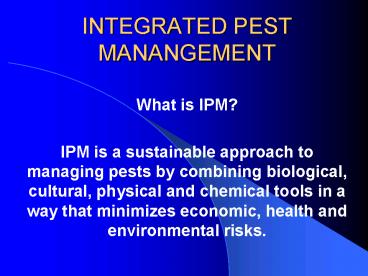INTEGRATED PEST MANANGEMENT - PowerPoint PPT Presentation
1 / 21
Title:
INTEGRATED PEST MANANGEMENT
Description:
point at which pest populations conditions indicate that pest ... Pathogens:Anthracnose of cucumber,fusarium wilt and halo blight mixed, added with Bacillus sp. ... – PowerPoint PPT presentation
Number of Views:63
Avg rating:3.0/5.0
Title: INTEGRATED PEST MANANGEMENT
1
INTEGRATED PEST MANANGEMENT
- What is IPM?
- IPM is a sustainable approach to managing pests
by combining biological, cultural, physical and
chemical tools in a way that minimizes economic,
health and environmental risks.
2
How do IPM programs work?
- Set Action Thresholds
- point at which pest populations conditions
indicate that pest control action must be taken.
Sighting a single pest does not always mean
control is needed.
3
Monitor and Identify Pests
- Not all insects, weeds, and other living
organisms require control. - Some organisms are beneficial.
- This monitoring and identification removes the
possibility that pesticides will be used when
they are not really needed.
4
Prevention
- To prevent pests from becoming a threat.
- Using cultural methods.
- Rotating between different crops
- Selecting pest-resistant varieties.
- Planting pest-free rootstock.
- Intercroping.
5
Control
- Once monitoring, identification, and action
thresholds indicate that pest control is
required, and preventive methods are no longer
effective or available, IPM programs then
evaluate the proper control method both for
effectiveness and risk.
6
Mechanical controls
- Hand-picking
- Using insects traps.
- Vacuuming
- Tillage to disrupt breeding
7
Plants to regulate insect pests
- Olfactory inhibitors odors that confuse and deter
pests. - Acting as trap.
- Serving as nursery plants for beneficial insects.
- ExampleSoldier beetle which is frequently found
on flowers as an adult, but whose larvae eat
aphids, caterpillars, and grasshopper.
8
(No Transcript)
9
(No Transcript)
10
Biological controls
- Natural biological processes and materials can
provide control, with minimal environmental
impact, and often at low cost. - Beneficial insects that eat target pests.
- Beneficial bacteria or fungi.
- Botanical pesticides.
11
Beneficial Insects
- Predatory mite feeding on immature insect
- Multicolored Asian lady beetle eating a winged
soybean aphid.
12
Bacillus thuringiensis (Bt)
- How it worksBt must be eaten by a susceptible
insect in order to be effective. - The microorganism produces endotoxin.
- The insect ceases to feed and dies within a few
days.
13
Botanical Pesticides
- Botanical pesticides are derived from plants
which have been shown to have insecticidal
properties. - Nicotine is extracted from the tobacco plant.
- Rotenone is a natural substance taken from the
stems and roots of certain tropical plants as
Jewel Vine or Flame tree (Derris Spp.), Lacepod
(Lonchocarpus spp.), and hoary pea (Tephrosia
spp.). - Pyrethrins are extracted from the seeds of a type
of chrysanthemum. - Flavonoids or alkaloids are extracted from plants
as horse tail (Equisetum leavigatum).
14
Neem (azadirachtin)
- How it works
- - Azadirachtin, acts as an insect growth
regulator. - - It has anti-feedant and oviposition deterrent
properties. - - Azadirachtin prevents insects from molting
- - Volatile compounds.
15
OMRI
- The Organic Materials Review Institute (OMRI) is
a national nonprofit organization that determines
which input products are allowed for use in
organic production and processing. - Approved products may be used to certified
organic under the USDA National Organic Program.
16
- Copper
- Downy Mildew, Early Blight, Late Blight,
Anthracnose, Cercospora leaf spot, Bacterial spot
- Onion, Peppers, Potato, Spinach, Tomato
- OMRI Listed
- Sulfur
- Powdery Mildew, Rusts, Leaf spots
- Most crops
- OMRI Listed
- Sesame Oil
- Nematodes
- All crops
- OMRI Listed.
17
Plants Resistance to Pests
- Host plant resistance
- - Physical Hairiness of leaves and stem
lignification. - - Chemical Alkaloids, glucosinolates, terpenoids
or polyphenols. - Induced plant resistance
- - PathogensAnthracnose of cucumber,fusarium wilt
and halo blight mixed, added with Bacillus sp.
Reduce cucurbitacin content. This reduce feeding
by cucumber beetles. - - Compost microorganisms in compost may also
control diseases by competing with the pathogen
for food or by producing compounds that kill the
pathogen.
18
Control of (Phytophtora infestans) with Biocides
in Tomato Plants
19
Horsetail Charara
20
Manure solution PE/411Manure solution
PE/83Charara Ch/43.3Charara
Ch/87.33Horse tail CC/42.36Horse
tail CC/82.33
21
Horse tail CC0.733Manure solution
PE0.383Charara Ch0.303































